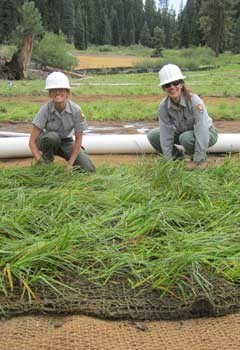
NPS Photo
Background
The National Park Service manages over 20 million acres of wetlands, including salt and freshwater marshes, swamps, peatlands, mudflats, intertidal zones, and similar aquatic areas. These highly productive and biologically diverse systems enhance water quality, control erosion, maintain stream flows, sequester carbon, and harbor at least 35 percent of threatened and endangered species. Their aesthetic appeal, diverse recreational opportunities, and important cultural landscape contributions make wetlands an integral part of the park visitor experience.
Unfortunately, wetlands are threatened on a national scale. Less than half of the wetland acreage that existed in the lower 48 states at the time of European settlement remains today. Although many wetlands in the National Park System remain largely unaltered, many others have been damaged by drainage, road-building, agriculture, mining, oil and gas development, and other activities.
In response to this resource degradation and loss, the NPS has established strong servicewide wetland protection policies and procedures, is acquiring baseline wetland inventory data, and is actively restoring degraded and lost wetlands. The Water Resources Division’s Wetlands Program plays important roles in each of these activities.
Wetlands Protection Policy and Procedures
The Wetlands Program is responsible for developing the NPS wetland protection policies and procedures found in Director’s Order #77-1: Wetland Protection (2002), Procedural Manual #77-1 (2016), and NPS Management Policies (2006), available at https://home.nps.gov/applications/npspolicy/index.cfm. They establish a “no-net-loss of wetlands” policy for the NPS, which requires avoiding, minimizing, and compensating for adverse impacts on wetlands. If a proposed action will have such impacts, then compliance with these policies and procedures must be recorded in a Wetland Statement of Findings (WSOF).
One of the most important program functions is review and certification of WSOFs. During this process, program staff frequently advise parks on ways to avoid or minimize wetland loss, and help identify opportunities for wetland compensation. For 88 WSOFs that WRD has certified since 2001, wetland impacts were limited to 290 acres and commitments to restore damaged or lost wetlands as compensation exceeded 619 acres. This 2:1 compensation ratio helps ensure consistency with the NPS no-net-loss of wetlands policy. Other related program activities include development of NPS wetland mitigation banks, review and comment on proposed federal wetland laws, policies and regulations, and participation on interagency committees charged with coordinating wetland technical and policy issues.
Servicewide Degraded Wetlands Inventory
The WRD Wetlands Program is working with cooperators to develop an inventory of degraded wetlands on NPS lands. Inventory products will include tabular and geo-spatial databases that will allow the NPS to identify regional and servicewide wetland restoration backlogs and help parks identify restoration needs, costs, and related information. The process involves three levels of assessment tailored to the needs and capacities of parks. Level 1 assessments are desktop analyses (e.g., air photo interpretation) followed by webinars with park staff members to identify degraded wetlands and prioritize restoration opportunities. Level 2 assessments involve site visits for field verifications, development of restoration concepts and cost estimation. For parks that are ready to forge ahead with restorations or prepare funding proposals, the team can perform Level 3 assessments that include hydrologic evaluations, more detailed restoration design and implementation concepts, and budgets.
Project benefits include:
- Parks can identify restoration opportunities to help meet natural resource goals or compensate for infrastructure projects that impact wetlands
- NPS can assess its wetland resource conditions servicewide and direct funding for restoration
- NPS can make the inventory available to the private-sector, including philanthropic organizations, wetland permit applicants, or wetland mitigation banking interests who can restore wetlands on NPS lands.
Restoration and Management of Wetland and Riparian Areas
Restoring wetland and riparian area health is a cornerstone of the Wetlands Program. Program staff provide technical assistance in all phases of restoration including condition assessments, hydrologic evaluations, planning and design, project implementation, and post-project monitoring.Since 2000, program staff have provided restoration assistance to more than 90 NPS units.
Highlights include:
- John D. Rockefeller Jr. Memorial Parkway
- Moores Creek National Battlefield
- Sequoia National Park
- Channel Islands National Park
- Pecos National Historical Park
- Palo Alto Battlefield National Historical Park
Last updated: August 16, 2024
